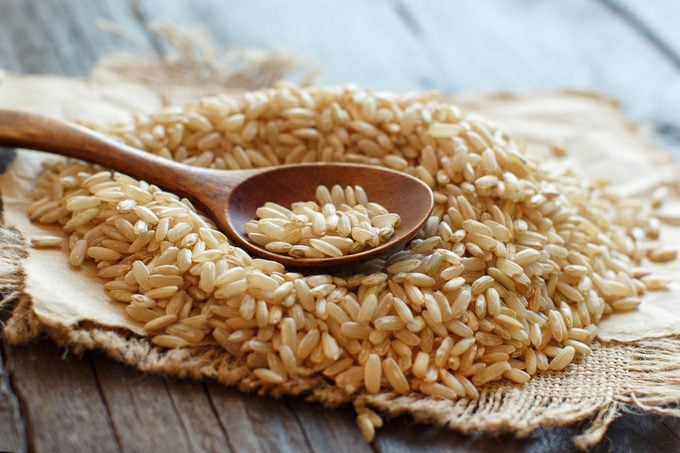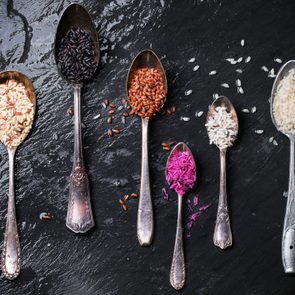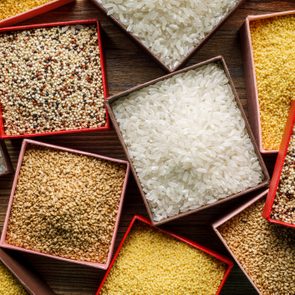Does Brown Rice Really Have Arsenic in It?
Updated: Jun. 21, 2021
Brown rice is more nutritious than white rice, but it also comes with more arsenic. Here's what you should know about arsenic in rice and how it might affect you.
Arsenic in brown rice
Brown rice is a health food staple that easily beats white rice for nutrition. But it can also contain arsenic, a toxic substance.
Before you toss every grain of brown rice from your pantry, let’s take a look at the concerns and what you can do to minimize them.
What is arsenic?
“Arsenic is naturally occurring,” says Kenneth Spaeth, MD, chief of occupational and environmental medicine at Northwell Health in Great Neck, New York. “It’s part of the Earth’s crust.”
That means it’s underfoot everywhere—including in the soil and the plants that grow in it. Of course, something naturally occurring can still be bad for you to eat.
In fact, according to the U.S. National Toxicology Program, arsenic is linked to several cancers, including lung, skin, liver, and bladder cancers.
Research also has shown a connection between inorganic arsenic and heart disease, diabetes, and respiratory problems.
The two types of arsenic
Arsenic can be found in two forms: organic and inorganic.
Organic arsenic is found mainly in fish and shellfish. Considering the low toxicity of this type of arsenic, there’s not a huge concern about arsenic in seafood.
Inorganic arsenic, which is the more toxic form, occurs when arsenic combines with an element other than carbon, such as oxygen, one of two elements that make up water. Inorganic arsenic is commonly found in groundwater, soil, and industrial chemicals.
Rice contains inorganic arsenic.
“The arsenic in rice is mostly a function of the naturally occurring arsenic in the soil,” says Dr. Spaeth. Industrial contamination may be less to blame, although some arsenic in soil is the result of old arsenic-based pesticides.
While arsenic can be found in trace amounts in many types of food, it has been found in higher levels in rice.
How arsenic gets into brown rice
Compared with other foods, rice tends to have the highest amount of arsenic.
According to a study published in 2017 in the journal Science of the Total Environment, rice accumulates 10 times more arsenic than other grains, such as wheat and barley. One reason for that: rice grows submerged in water and therefore absorbs more of the arsenic found in that water.
According to the U.S. Food and Drug Administration (FDA), brown rice contains about 50 percent more arsenic than white rice does because a good deal of that arsenic collects in the bran, or the outer portion of the rice grain.
The bran is removed when producing white rice. As Dr. Spaeth, an expert in heavy metal toxicity, points out, “the arsenic in the bran is stripped away in processing.”

How much arsenic is in the brown rice in my pantry?
That’s hard to say, according to Dr. Spaeth. He points out that rice packages generally don’t indicate whether the company has assessed the arsenic level.
The amount of arsenic depends on where the rice was grown.
Arsenic levels in the soil vary from region to region throughout Asia, where rice is grown and consumed in abundance, but they also vary among the rice-growing regions in the United States.
“There’s no way for consumers to know the amount and to make informed choices,” Dr. Spaeth says.
Regulating arsenic in rice
Another complicating factor: the FDA does not regulate the amount of arsenic in rice products, including rice cereals and rice milks, except for rice cereals meant for infants.
The federal agency has set 100 parts per billion (ppb) as the upper limit for inorganic arsenic in infant rice cereal. The average concentration of arsenic in brown rice is 154 ppb, or 50 percent higher than the limit set for infant rice cereals.
The FDA estimates that eating 20 servings of white rice each week from birth to age 6 multiplies your lifetime risk of lung and bladder cancers by about five times that of people who ate fewer than five weekly servings as infants and very young children.
That cancer risk remains quite small, however, accounting for only 100 cases for every 1 million people in the United States.
Keep in mind: brown rice has benefits
Brown rice boasts a lot of nutrition. Unlike white rice, brown rice is a whole grain that contains the grain’s germ and bran, where most of the nutrition can be found.
White rice contains only the endosperm. While you still get some calcium, iron, folate, and vitamin E in white rice, you lose most of the B vitamins and other nutrients found in brown rice. You also lose much of the fiber.
“Having all three parts of the grain allows for it to be rich in nutrients,” says Kayla Kirschner, a registered dietitian at Lenox Hill Hospital in New York City. “Brown rice has more protein, fiber, thiamin, and magnesium than white rice.”
To eat or not to eat brown rice
Dr. Spaeth says moderate amounts of brown rice should not be cause for concern.
“If you eat rice in an amount typical of a Western diet, it’s probably not an issue as it is in parts of the world where it’s more of a daily staple,” he says.
In the United States, for example, the average person eats about 23 pounds of rice per year, while an average person in Japan eats about seven times that amount.
Dr. Spaeth agrees with the FDA’s concern about rice products for infants. He also points out that people who follow gluten-free diets tend to eat more rice than the average person, so their arsenic consumption may be a bit higher than normal.
“But there’s probably no need for extreme worry if people are consuming it in a typical way—if it’s not a central, regular part of their diet,” he says.
Still, there are no guidelines for how much brown rice may be too much. It would be complicated to attempt such guidelines because, as Dr. Spaeth says, the amount of arsenic in rice varies depending on where it’s grown.
You can reduce the amount of arsenic in rice in general by cooking it similar to pasta—using six to 10 parts water to 1 part rice and then draining the excess. This can reduce the inorganic arsenic by 40 to 60 percent, according to the FDA. However, for enriched white rice, this method also reduces the amount of nutrients in the rice.
One 2020 study found that soaking brown rice in water in a ratio of three parts water to one part rice for four hours also reduced arsenic levels.
Try something new
Kirschner’s solution is the advice she shares with all of her clients: mix things up.
“I recommend a variety of whole grains,” she says. “This is important because each grain provides slightly different nutrition, including calories, fiber, vitamins, and minerals. Introducing a variety of foods is important for all food groups and not just whole grains, as the nutrition in all foods varies.”
Wheat berries, bulgur, and amaranth are just three examples of tasty whole grains you could swap for brown rice. For more ideas, read about how to eat more whole grains.





















